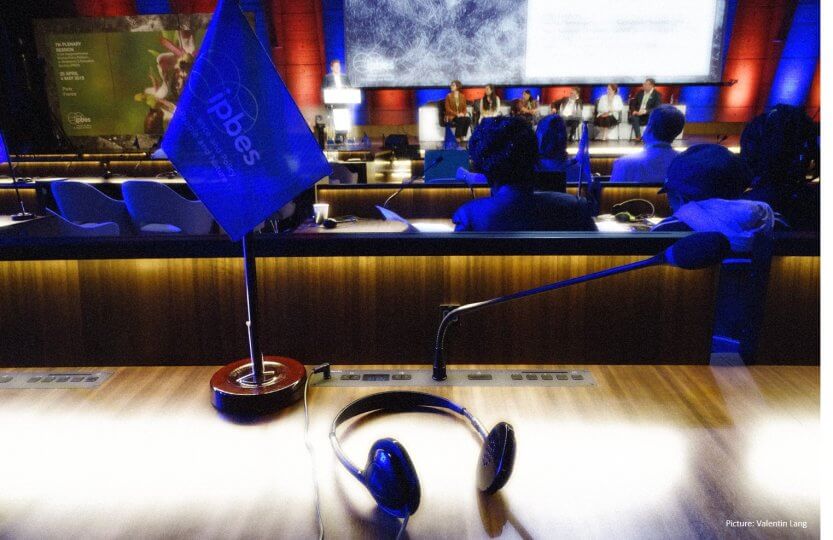At the IPBES-7 conference, 132 member states cooperated. How did communication work with such a variety of different countries and languages? As I wanted to know more about it, I went to the interpretation cabins in one of the lunch breaks and spoke with a technician who was sitting next to the interpreters and who was responsible for the technology in the plenary hall.
Multilingualism enables communication between all the member states and ensures participation of all countries in the discussions and meetings. The conference communication is based on the six official languages of the UN, namely Arabic, Chinese, English, French, Russian and Spanish. Delegates may speak in any of these languages while having their speech simultaneously translated into the other official languages.
At the IPBES-7 conference, there were two interpreters for each language. As the work requires high concentration each interpreter translates for 30-minutes intervals. Additionally, there are two pairs of interpreters. One of them is working the first half of the day, the other pair is working the second half of the day. As the interpreters do not speak all these six languages, they sometimes use the English interpretation to translate it into their language. The Spanish interpreter, for example, can use the English interpretation of the Chinese speech of a delegate to translate it into Spanish. This may cause a short delay for the listener.
It was very interesting to learn how languages are translated during an intergovernmental conference. Their work enables clear and concise communication between the delegates of many different countries.
Search
Subscribe now!
Welcome to the GCE Blog!
We are students of the master program Global Change Ecology at Uni Bayreuth. We care about planet Earth and we will be writing about topics such as ecology, environment, society, climate change and action and GCE activities.Recent Posts
All maps are wrong, but some are useful
22. Feb , 2024 2 Comments
GCE Excursion to Bamberg 2023
11. Dec , 2023 1 Comment
Empowering the Young – Visiting the LCOY Climate Conference 2023
23. Nov , 2023 2 Comments
OPEN FOR APPLICATIONS: M.Sc. Global Change Ecology
01. Mar , 2023 2 Comments
Sparking action: How awe can reconnect us to our planet
08. Feb , 2023 2 Comments
Categories
- About 1
- Biomes 1
- CBD COP14 – 2018 2
- CBD COP15 – 2022 1
- Christmas 1
- Conferences 43
- Conservation 2
- COP21 – 2015 8
- COP23 – 2017 28
- COP24 – 2018 2
- COP26 – 2021 3
- COP27 – 2022 1
- Deutsch 8
- Eco News 8
- GCE & Student Activities 50
- GCE Activities 21
- GCE Tips 3
- Global Change and Health 1
- Halting Deforestation – 2018 2
- IPBES 5 – 2017 7
- IPBES 6 – 2018 2
- IPBES 7 – 2019 8
- IPBES 8 – 2021 1
- IPBES 9 – 2022 1
- Master Thesis 1
- Opinion 55
- Student Activities 51
- Sustainability 18
- Sustainable Bayreuth 7
- Uncategorized 29
- Wild Facts 24
Archive
- February 2024 (1)
- December 2023 (1)
- November 2023 (1)
- March 2023 (1)
- February 2023 (1)
- January 2023 (1)
- December 2022 (2)
- November 2022 (2)
- September 2022 (2)
- August 2022 (2)
- June 2022 (3)
- May 2022 (2)
- April 2022 (1)
- March 2022 (2)
- February 2022 (1)
- January 2022 (2)
- December 2021 (3)
- November 2021 (3)
- October 2021 (4)
- September 2021 (5)
- August 2021 (4)
- July 2021 (3)
- June 2021 (4)
- May 2021 (4)
- April 2021 (3)
- March 2021 (3)
- February 2021 (3)
- January 2021 (3)
- December 2020 (4)
- November 2020 (5)
- October 2020 (4)
- September 2020 (5)
- August 2020 (3)
- July 2020 (4)
- June 2020 (7)
- May 2020 (4)
- April 2020 (5)
- March 2020 (3)
- January 2020 (1)
- December 2019 (2)
- November 2019 (5)
- October 2019 (4)
- September 2019 (3)
- August 2019 (3)
- June 2019 (3)
- May 2019 (2)
- April 2019 (5)
- February 2019 (4)
- January 2019 (1)
- December 2018 (2)
- November 2018 (2)
- October 2018 (6)
- September 2018 (1)
- August 2018 (5)
- July 2018 (7)
- June 2018 (2)
- May 2018 (4)
- April 2018 (11)
- March 2018 (11)
- February 2018 (2)
- January 2018 (1)
- December 2017 (1)
- November 2017 (26)
- October 2017 (4)
- September 2017 (1)
- March 2017 (7)
- May 2016 (1)
- December 2015 (12)
- November 2015 (1)
- January 2015 (4)
- November 2013 (9)
- February 2012 (1)
- September 2011 (1)









